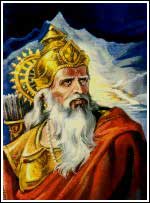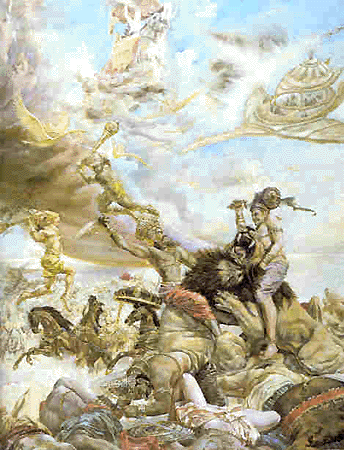|
Āditya, meaning "of or related to Aditi", refers to the offsprings of Aditi. Adityas are solar class deities.
In later Hinduism, Aditya is used in the singular to mean the sun.
The Adityas being Solar deities have been described in the Rig Veda as bright and pure as streams of water, free from all guile and falsehood, blameless, perfect.
These class of deities have been attributed to as upholding the movables and immovable Dharma. Adityas are beneficent Gods who act as protectors of all beings, who are
provident and guard the world of spirits. In form of Mitra-Varuna, the Adityas are true to the eternal Law and act as the debt exactors.
In present day usage in Sanskrit, the term Aditya has been made singular in contrast to Vedic Adityas, and are being used synonymously with Surya, the Sun.
The Vedas do not identify the Ādityas and there is no classification of the thirty-three gods, except for in the Yajurveda (7.19), which says
there are eleven gods in heaven (light space), eleven gods in atmosphere (intermediate space), and eleven gods in earth (observer space).
In the Satapatha Brahmana, the number of Ādityas is eight in some passages, and in other texts of the same Brahmana, twelve Adityas are mentioned.
Āditya in the (Chāndogya-Upaniṣad) is also a name of Viṣṇu, in his avatar known as Vāmana, the dwarf. His mother is Aditi. In the later
Puranic texts, all Hindu deities were referred to as Adityas. Hence, the number of Adityas increased to
33,000,000.
Vasus are attendant deities of Indra, and later Vishnu. They are eight elemental
gods representing aspects of nature, representing cosmic natural phenomenon. The name Vasu means 'Dweller' or 'Dwelling'. They are eight among the Thirty-three gods.
There are varying lists of the eight Vasus in different texts, sometimes only because particular deities have varying names.
In the Ramayana the Vasus are children of the sage Kashyapa by Aditi and so are full siblings to the Adityas. However the Mahabharata makes them sons of Prajāpati son
of Manu son of Brahma by various mothers.
The Mahabharata relates how the Vasus, led by "Prithu" (presumably here a male form of Privthvi) were enjoying themselves in the forest, when the
wife of Dyaus spotted
an excellent cow and persuaded her husband Dyaus to steal it, which he did with the agreement and aid of Pirthu and his other brothers. Unfortunately for the Vasus, the
cow was owned by the sage Vasishta who learned through his ascetic powers that the Vasus had stolen it and immediately cursed them to be born on earth as mortals.
Vasishta responded to pleading by the Vasus by promising that seven of them would be free of earthly life within a year of being born and that only Dyaus would pay
the full penalty. The Vasus then requested the river-goddess Ganga to be their mother. Ganga incarnated and became the wife of King Santanu on condition that he never
gainsaid her in any way. As seven children were born, one after the other, Ganga drowned them in her own waters, freeing them from their punishment and the king made
no opposition. Only when the eighth was born did the king finally oppose his wife, who therefore left him. So the eighth son, Dyaus incarnated, remained alive,
imprisoned in mortal form, and later became known in his mortal incarnation as Bhishma.
A later section of the Mahabharata gives an alternate version in which each of the Vasus gives a portion of himself to create a ninth being and so all eight are
later drowned leaving only this ninth composite as an incarnation of parts of all the Vasus to live out a very long mortal life as Bhishma. Vasu is also the name
of the eighth chakra (group) of Melakarta ragas in Carnatic music. The names of chakras are based on the numbers associated with each name. In this case, there
are eight Vasus and hence the eighth chakra is Vasu. because particular deities have varying names.
In the Ramayana the Vasus are children of the sage Kashyapa by Aditi and so are full siblings to the Adityas. However the Mahabharata makes them sons of Prajāpati son
of Manu son of Brahma by various mothers.
The Mahabharata relates how the Vasus, led by "Prithu" (presumably here a male form of Privthvi) were enjoying themselves in the forest, when the
wife of Dyaus spotted
an excellent cow and persuaded her husband Dyaus to steal it, which he did with the agreement and aid of Pirthu and his other brothers. Unfortunately for the Vasus, the
cow was owned by the sage Vasishta who learned through his ascetic powers that the Vasus had stolen it and immediately cursed them to be born on earth as mortals.
Vasishta responded to pleading by the Vasus by promising that seven of them would be free of earthly life within a year of being born and that only Dyaus would pay
the full penalty. The Vasus then requested the river-goddess Ganga to be their mother. Ganga incarnated and became the wife of King Santanu on condition that he never
gainsaid her in any way. As seven children were born, one after the other, Ganga drowned them in her own waters, freeing them from their punishment and the king made
no opposition. Only when the eighth was born did the king finally oppose his wife, who therefore left him. So the eighth son, Dyaus incarnated, remained alive,
imprisoned in mortal form, and later became known in his mortal incarnation as Bhishma.
A later section of the Mahabharata gives an alternate version in which each of the Vasus gives a portion of himself to create a ninth being and so all eight are
later drowned leaving only this ninth composite as an incarnation of parts of all the Vasus to live out a very long mortal life as Bhishma. Vasu is also the name
of the eighth chakra (group) of Melakarta ragas in Carnatic music. The names of chakras are based on the numbers associated with each name. In this case, there
are eight Vasus and hence the eighth chakra is Vasu.
Rudra is associated with wind or storm, and the hunt. The name has been translated as
"The Roarer", or "The Howler". The theonym Shiva originates as an epithet of Rudra, the adjective shiva "kind" being used euphemistically of the god who in the Rigveda
also carries the epithet ghora "terrible". Usage of the epithet came to exceed the original theonym and by the post-Vedic period (in the Sanskrit Epics), the name
Rudra is taken as a synonym for the god Shiva and the two names are used interchangeably.
The etymology of the theonym Rudra is somewhat uncertain. It is usually derived from the root rud- which means "to cry, howl." According to this etymology,
the name Rudra has been translated as "the Roarer". An alternate etymology derives Rudra ("the Red, the Brilliant") from a lost root
rud- "to be red" or "to be ruddy", or "to shine". A different etymology connected with the adjectival form
raudra, which means wild, of rudra nature, and translates the name Rudra as "the Wild One" or "the Fierce God".
The adjective shivam in the sense of "propitious" or "kind" is applied to the name Rudra in
Rig Veda 10.92.9. Shiva used as a name or
title (Sanskrit śiva, "the kindly/auspicious one") occurs only in the late Vedic Katha Aranyaka. Rudra was called Shiva for the first time
in the Śvetāśvatara Upanishad.
Rudra is called "The Archer" (Sanskrit: Śarva) and the arrow is an essential attribute of Rudra. This name appears in the Shiva Sahasranama, often in later languages. The word is derived from the Sanskrit root śarv- which means "to injure" or "to
kill" and in interpretive translation of the name Śarva as "One who can kill the forces of darkness". The names
Dhanvin ("Bowman") and Bāṇahasta ("Archer", literally "Armed with arrows in his hands") also refer to archery.
The earliest mentions of Rudra occur in the Rigveda, where three entire hymns are devoted to him. There are about seventy-five references to Rudra in
the Rigveda overall. In the Rigveda Rudra's role as a frightening god is apparent in references to him as ghora ("terrible"), or simply as asau devam ("that
god"). He is "fierce like a formidable wild beast" (Rig Veda 2.33.11). In
Rig Veda 7.46, Rudra is described as armed with a bow and fast-flying arrows. The hymn says Rudra discharges "brilliant shafts which run about the heaven and the earth" (Rig
Veda 7.46.3), which may be a reference to the
destructive power of lightning.
Rudra was believed to cause disease, and when people recovered from them or were free of them, that too was attributed to the agency of Rudra. He is asked not to afflict children with disease (Rig
Veda 7.46.2) and to keep villages free of illness (Rig
Veda 1.114.1). He is said to have healing remedies (Rig
Veda 1.43.4),
as the best physician of physicians (Rig Veda 2.33.4), and as possessed of a thousand medicines (Rig
Veda 7.46.3). This is described in Shiva's alternative name
Vaidyanatha (Lord of Remedies).
Ashvins are divine twin horsemen in the Rig
Veda, sons of Saranya (daughter of vishwakarma), a
goddess of the clouds and wife of Surya in his form as Vivasvat. The Ashvins are Vedic gods symbolising the shining of sunrise and sunset, appearing in the
sky before
 the dawn in a golden chariot, bringing treasures to men and averting misfortune and sickness. the dawn in a golden chariot, bringing treasures to men and averting misfortune and sickness.
They can be compared with the Dioscuri (the twins
Castor and Pollux) of Greek and Roman mythology, and especially to the divine twins Ašvieniai of the ancient Baltic religion.
They are the doctors of gods and are devas of Ayurvedic medicine. The Divine twins are a mytheme of Proto-Indo-European mythology: the Greek Dioscuri, the Vedic Ashvins, the Lithuanian Ašvieniai, the Latvian Dieva dēli
Alcis (gods), Romulus and Remus, Hengest and Horsa.
They are called Nasatya (dual nāsatyau "kind, helpful") in the Rig
Veda; later, Nasatya
is the name of one twin, while the other is called Dasra ("enlightened giving"). By popular etymology, the name nāsatya was analysed as na+asatya "not
untrue"="true".
In the epic Mahabharata, King Pandu's wife Madri is granted a son by each Ashvin God and bears the twins Nakula and Sahadeva who, along with the sons of
Kunti, are known as the Pandavas. To each one of them is assigned the number
7 and to the pair the number 14.
Ashvini is the name of an asterism in Indian astronomy, later identified with the mother of the Ashvins. This asterism forms the first of the
27 asterisms
that form the zodiac in Indian astronomy. This star is identified as Hamal, the brightest star in the constellation of Aries (Alpha Arietis).
Maruts also known as the Marutgana and the Rudras, are storm deities and sons of Rudra and Diti and attendants of Indra. The number of Maruts varies from two to
sixty (three times sixty in Rig Veda 8.96.8). They are very violent and aggressive, described as armed with golden weapons i.e. lightning and thunderbolts, as having
iron teeth and roaring like lions, as residing in the north, as riding in golden chariots drawn by ruddy horses.
In the Vedic mythology, the Maruts, a troop of young warriors, are Indra's companions.
They are
cognate to the Einherjar and the Wild hunt.
According to the Ramayana, the Maruts' mother, Diti, either seven or seven times seven in number, hoped to give birth to a son who would be more powerful than
Indra. She remained pregnant for one hundred years in hopes of doing so; Indra prevented it by throwing a thunderbolt at her and splintering the fetus into the
many less powerful deities.
|

